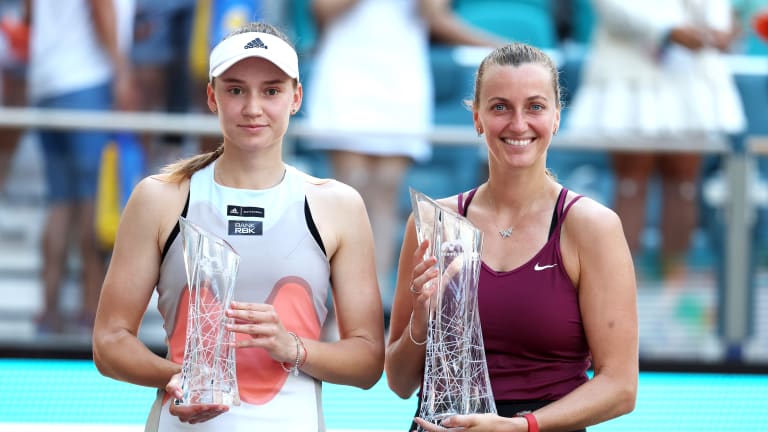Just over a year ago, Petra Kvitova’s ranking matched her age. She’d turned 32 on March 8, 2022. Thirteen days later, she began the Miami Open with the same number next to her name. This was not the kind of territory a player of Kvitova’s history and caliber is expected to occupy.
Or was it? After all, 12 months ago, Kvitova appeared to be primarily a highly regarded ancestor to the contemporary brand of baseline power displayed more recently and forcefully by such current stars as Iga Swiatek, Aryna Sabalenka and Elena Rybakina. As a two-time Wimbledon champion, Kvitova might continue to have her moments, but could she once again win big titles? Hardly likely in Miami, where Kvitova’s best efforts in 12 prior appearances were a scant three trips to the quarterfinals.
But over the last 10 days, Kvitova reminded us just how effective her left-handed blend of power and accuracy can be. Kvitova’s skill was vivid in today’s final, when she took an hour and 42 minutes to beat Rybakina, 7-6 (14), 6-2. It was Kvitova’s 30th career singles title and puts her back into the Top 10 for the first time since Sept ’21. At 33, she’s the oldest woman to win the Miami Open since Serena Williams in 2015.
“I think I just take it very positively that I can still compete with the best,” said Kvitova. “The tennis world is just very fast, and I can't really stand there and be watching this trophy all the time, but I have to move forward, of course, as everybody would. It means a lot for me that even in my age I can still win a big tournament. That's the biggest thing.”
Of the match’s 102 minutes, 80 of them took a backseat to the 22 that comprised the first set tiebreaker. Fitting indeed that boxing legend Mike Tyson was on-hand to watch these two go toe-to-toe. Kvitova and Rybakina played exemplary first-strike tennis, each player frequently proving the non-negotiable premise that the two most important shots in tennis are the serve and the return.
Rybakina’s first three service points of the tiebreaker were aces. All told, she’d hold five set points in the tiebreaker. Each time, Kvitova had the answer, never backing off from the ground or with her serve—particularly the wide one in the ad court that usually opens up the court for a lethal forehand. Holding a fifth set point of her own when serving at 15-14, Kvitova took charge of a baseline rally well enough to extract a netted Rybakina forehand.
“It was like one mini break and then other one and we just kept going on the serves,” said Kvitova. “I mean, I totally lost the control of who is serving, who is not, when we are changing the sides and so on."
This was the first tiebreaker in eight tries Rybakina had lost all year. “It took me time to get used to Petra's balls,” said Rybakina. “Also, she plays really low, and it's not easy against her. And also to try to read the serves, she's lefty, so it's already kind of advantage, because last match I played with a righty, so it was not easy. And she played really well.”
